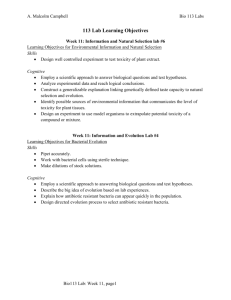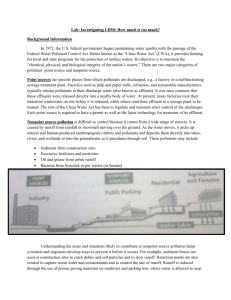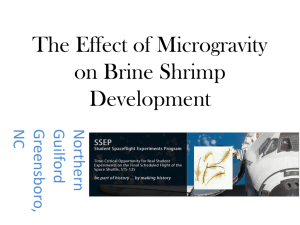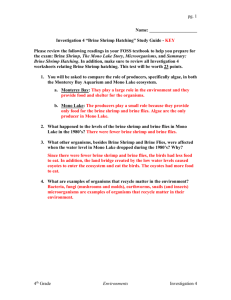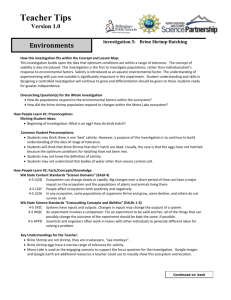How Do Brine Shrimp Select a Habitat?
advertisement
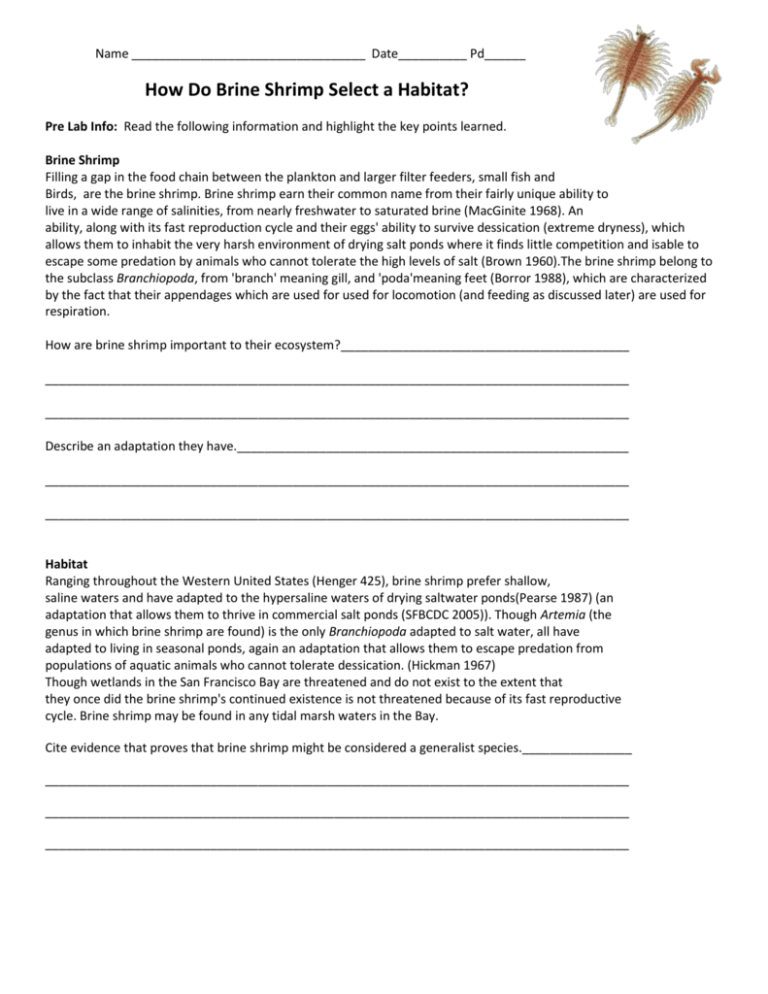
Name __________________________________ Date__________ Pd______ How Do Brine Shrimp Select a Habitat? Pre Lab Info: Read the following information and highlight the key points learned. Brine Shrimp Filling a gap in the food chain between the plankton and larger filter feeders, small fish and Birds, are the brine shrimp. Brine shrimp earn their common name from their fairly unique ability to live in a wide range of salinities, from nearly freshwater to saturated brine (MacGinite 1968). An ability, along with its fast reproduction cycle and their eggs' ability to survive dessication (extreme dryness), which allows them to inhabit the very harsh environment of drying salt ponds where it finds little competition and isable to escape some predation by animals who cannot tolerate the high levels of salt (Brown 1960).The brine shrimp belong to the subclass Branchiopoda, from 'branch' meaning gill, and 'poda'meaning feet (Borror 1988), which are characterized by the fact that their appendages which are used for used for locomotion (and feeding as discussed later) are used for respiration. How are brine shrimp important to their ecosystem?__________________________________________ _____________________________________________________________________________________ _____________________________________________________________________________________ Describe an adaptation they have._________________________________________________________ _____________________________________________________________________________________ _____________________________________________________________________________________ Habitat Ranging throughout the Western United States (Henger 425), brine shrimp prefer shallow, saline waters and have adapted to the hypersaline waters of drying saltwater ponds(Pearse 1987) (an adaptation that allows them to thrive in commercial salt ponds (SFBCDC 2005)). Though Artemia (the genus in which brine shrimp are found) is the only Branchiopoda adapted to salt water, all have adapted to living in seasonal ponds, again an adaptation that allows them to escape predation from populations of aquatic animals who cannot tolerate dessication. (Hickman 1967) Though wetlands in the San Francisco Bay are threatened and do not exist to the extent that they once did the brine shrimp's continued existence is not threatened because of its fast reproductive cycle. Brine shrimp may be found in any tidal marsh waters in the Bay. Cite evidence that proves that brine shrimp might be considered a generalist species.________________ _____________________________________________________________________________________ _____________________________________________________________________________________ _____________________________________________________________________________________ Other Physiology The elongated body is covered with a thin exoskeleton and usually consists of 19 segments, the first 11 of which have pairs of appendages, the next two which are often fused together carry the reproductive organs and finally the last lead to the tail (Hickman 1967). Though brine shrimp have a true head, thorax and abdomen, the delineation is often difficult to detect and so the body parts are usually termed as head and trunk (Brown 1960). The rudimentary, compound eyes, set at the end of short stalks perform little more detecting light direction and intensity, though they may be able to aid in orientation based on the polarization of sunlight and are keen at detecting light movement which might indicate the advancement of predators. (Hickman 1967) Locomotion is achieved by the rhythmic beating of the appendages acting in pairs. Steering is accomplished by use of the telson (a type of flattened tail). The telson may also be used for rapid movements for escaping prey (Brown 1960). Respiration occurs on the surface of the legs through fibrous, feather like plates (lamellar epipodites) (Hickman 1967). In addition to locomotion, feeding and respiration, the legs or appendages serve to aid in the circulation of blood despite the existence of a long tube like heart. The blood which uses hemoglobins as its primary oxygen fixing pigment and lends the brine shrimp its pink color, does not flow through veins but rather flows in the hemocoelic spaces of the head and throughout the trunk and appendages (Brown 1960). The nervous system consists of two parallel chains leading from a small brain down length of the body and is cross connected (like a ladder) in each segment or somite.(Brown 1960) Many functions, including swimming, digestion and reproduction are not controlled through the brain though the brain may control some regulation or synchronization of these functions. Autonomy, the voluntary shedding or dropping of parts of the body for defense, is controlled locally along the nervous system aswell. (Hickman 1967) How do brine shrimp respond to light and why?______________________________________________ _____________________________________________________________________________________ _____________________________________________________________________________________ Explain how brine shrimp detect change in their environment.__________________________________ _____________________________________________________________________________________ _____________________________________________________________________________________ Human interactions Though human encroachment in the San Francisco Bay has dramatically reduced the amount of wetland habitat and had a dramatic impact on other marine organisms, the adaptability and rapid reproductive cycle of brine shrimp has lead to their continued existence. One of the encroachments into the Bay is in the form of salt ponds in the South Bay where salt is commercially harvested but doubles as a brine shrimp breading ground and farm. Before the salt is harvested, brine shrimp, being the only animals capable of living in the harsh salty environment, may be harvested and sold for use in research and as tropical fish food. The high densities of the brine shrimp in commercial salt ponds also makes them an abundant food source for many common birds on the bay such as grebes, gulls and sandpipers. (SFBCDC 2005)Brine shrimp may also find human interactions in the handling of farm and industrial waste in that they may be used to disperse naturally occurring selenium and salts in waste waters. In this case algae is grown in the waters upon which the brine shrimp will feed who will in turn be fed upon by birds, whence the salts and selenium will be redistributed into the environment.(CDWR 2007) Brine Shrimp Lab Activity: Background: Different organisms are adapted for life in different habitats. For example, brine shrimp are small crustaceans that live in saltwater lakes. Organisms select habitats that provide the conditions (such as specific temperature range and amount of light) to which they are best adapted. In this investigation, you will explore habitat selection by brine shrimp and determine which environmental conditions they prefer. Individual organisms within a population respond to some parts of the environment and ignore others. Many characteristics of a habitat vary from time to time or place to place. Environmental factors such as temperature and light vary in all habitats. Where one specific environmental factor varies continuously over distance, a gradient forms. Light intensities can range from absolute darkness to extreme brightness. A shady spot may be a few degrees cooler than a position in direct sunlight a few meters away. Certain conditions are more suitable for an organism to thrive. In addition, individuals differ in their ability to detect & respond to environmental changes. In order to determine the significance of an environmental factor on a specific kind of organism, we first isolate the factor from other variables. We next present the organism with a gradient along which it can move to select most favorable conditions. If the organism moves to a specific position along the gradient, we know that: 1) the particular variable was detected by the organism, and 2) it selected a particular intensity of that variable. In order to guard against the possibility of overlooking hidden variables in your experiment, you must have a control where no variables are present. Only then can you compare how the organism in the control behaved differently from those in the experimental group. In this lab you will apply the scientific method by setting up an experimental situation, carefully and accurately collecting data, and finally analyzing data to determine which environmental factors (variables) are significant to the organism and how great the differences must be before the organism responds. ***************************************************************************** Question: Use your knowledge of Brine Shrimp to address the following question: What temperature, light factors, or pH are most favorable for brine shrimp habitat? We will be subjecting them to light/dark environments and hot/cold environments during our next class period. We want to predict what will happen when we do. Here are sample hypotheses… Example: If I expose brine shrimp to pH extremes, the brine will… a. swim towards the more acidic end because they prefer acidic environments in their natural habitats. b. swim towards the more basic end because they prefer basic environments in their natural habitats. c. swim towards the neutral portion because they prefer a more neutral environment in their natural habitat. State your Hypotheses: _________________________________________________________________________ _______________________________________________________________________________________________ _______________________________________________________________________________________________ Draw the pre-lab apparatus on the back of this handout. Materials: (will vary by group) ALL: “Gradient Apparatus” (1-meter plastic tubing, clamps) funnel, brine shrimp, brine, timer, Dependent by Group: General Procedure: 1. Set up your apparatus as shown during pre-lab. 2. Design your specific treatment according to your group. 3. Clamp one end completely. While holding your apparatus vertical (clamped end at bottom) use the funnel to carefully place your brine shrimp in the apparatus. Be careful not to overfill the tubing. 3a. Attempt an even distribution of brine shrimp across the gradient. 4. FOLLOW THE SPECIFIC DIRECTIONS FOR YOUR ASSIGNED GROUP. 5. Allow 30 minutes for your brine shrimp to detect and select. 6. Tightly close down each of the middle clamps and count shrimp in each section. 7. Record your data in correct row on the table and to your data to other groups. 8. Unclamp the tubing and return the brine shrimp to the “rehabilitation” container. 9. Return clamps, rinse out your tubing, and hang dry. Group #1: Control Group You are working with no variables and no gradient. Be certain that all conditions are identical along the length of the tubing. Your tubing should remain horizontal, in the dark, and have no temperature or pH differences. Your data will be the basis of comparison for other experimental groups. Group #2: Temperature Gradient You are working with one variable: temperature. Cover one end of the tubing with a bag of ice, while placing the other end 30 cm underneath an infrared heat lamp. Make sure the tubing is horizontal, and that pH and light differences are not going to influence your organism. Group #3: Light Gradient You are working with one variable: light. Make sure the tubing is horizontal, and that pH and temperature differences are not going to influence your organism. Place a weak light source at one end of the tubing. Starting at the 50cm mark and ending at the 100-cm mark along the tubing place a, place an opaque cover so that light can only arrive from your light source. It will be necessary to find a place in the lab where light is significantly reduced so your weak light source is the predominant light available.



